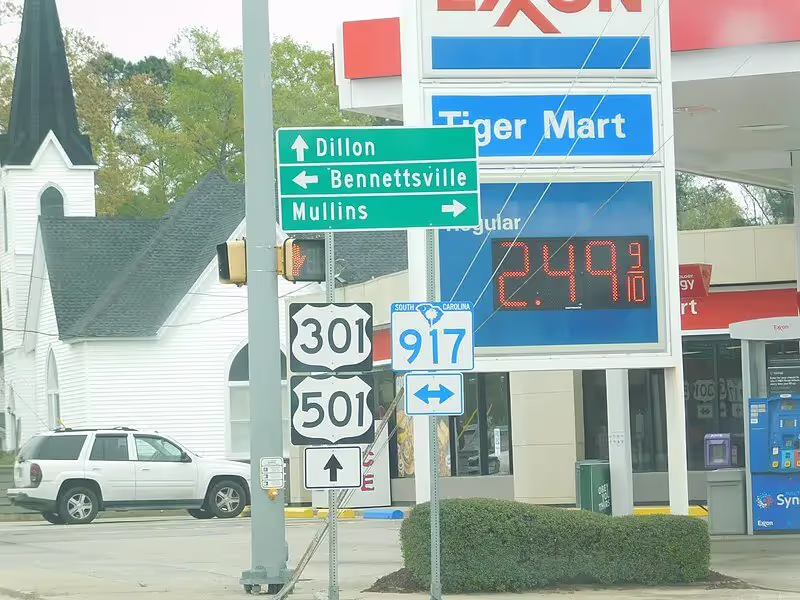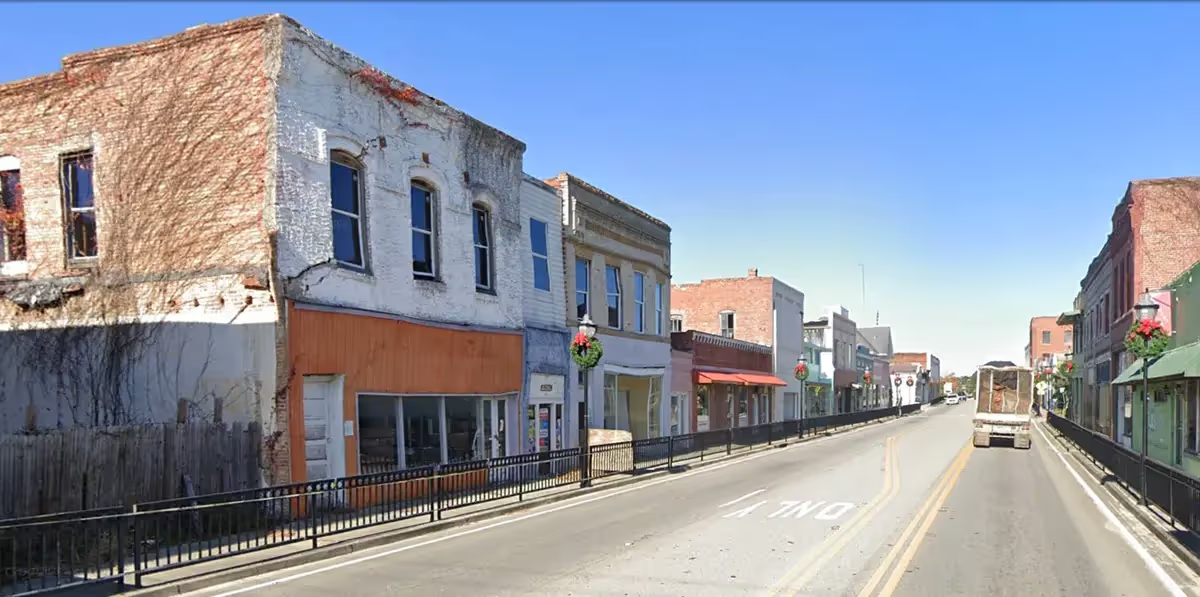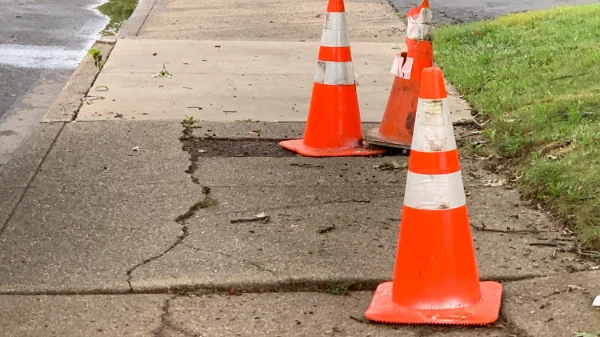A few years ago I was driving home from Christmas with the in-laws in Pennsylvania, when a monstrous slowdown on I-95 in South Carolina sent me on a multi-hour detour along parallel roads. Passing through the historic downtown of Bamberg, I slammed on the brakes to gawk in disbelief at what I was seeing.
It was several blocks of almost picture-perfect, classic Southern American urbanism. Gorgeous old brick buildings made only more appealing by the patina of age; a delightfully granular mix of narrow storefronts lining the sidewalk creating visually enticing edges to stroll; festive Christmas wreaths on the lamp posts just as in the Google Street View image here.
The catch: nearly every single storefront was vacant. It was like being in a ghost town, only Bamberg is still very much inhabited.
I mostly forgot about the place until a photo of the exact same town popped up on Twitter, and I just had to comment. You see, there’s one very obvious clue to what went wrong in Bamberg, South Carolina. It’s plainly visible when you drive through, and it’s the other reason I gawked (besides the historic beauty).
Bamberg, at some point, seems to have decided its Main Street should be a limited-access highway. In order to speed up the flow of cars on US-301, they’ve not only streamlined and widened the road; they’ve also cordoned off the narrow sidewalks behind wrought-iron railings, ensuring that nobody will cross the street on foot and slow down drivers.
Killing What Makes Downtown Downtown
We’ve written for years about the fundamental confusion between a street and a road. A city street should be a place for people to congregate, shop, socialize, and do all the human things that produce value for the community. A road—or highway—should be a high-speed, efficient connection between two places. These functions are mutually incompatible, because one requires fast movement and predictable driving conditions; the other requires slow vehicles for an environment that can safely accommodate chaos and serendipity. When you try to combine them, you get the worst of both worlds: the stroad.

Bamberg’s approach is a bit of a twist on the stroad theme. In the name of safety, they have simply sought to wall off the pedestrian environment from the motor vehicle one, and run a road—a high-speed vehicle thoroughfare—right through the middle of the street—a walkable destination lined with shops.
The result is, still, the worst of both worlds. It kills everything that makes downtown downtown. Small, idiosyncratic local businesses rely on walk-in visits by customers who stumble upon them while strolling, without any prior intention of shopping there. This will rarely happen in Bamberg. Access to these businesses is from back doors that open to parking lots; nobody is strolling these claustrophobic sidewalks. Anyone who wants to cross the street has had their walk extended by a block or longer. Drivers passing through town won’t be motivated to stop and explore, because there’s no easy, obvious way to do so. Hemmed in by that wall of railings, you just keep moving.
The railings make sense as a safety feature only because cars are moving fast: in other words, only if you start from the assumption that speeding up the flow of traffic is paramount. Then everything else follows, and you might as well make things pretty while you’re widening the highway. At least Bamberg civic leaders thought so. Here’s a news article from 2007 about the project:
Foster, who is president of the Historic Society of Bamberg County, said downtown will have a brighter look once the street renovation is completed.
"It's going to be beautiful when they finish, with wrought iron railings along the sidewalks and lampposts," Foster said.
Bamberg County Chamber of Commerce Executive Director Lisa B. Stokes said… "It will be a major boost to the economy for the county and downtown Bamberg.”
I imagine the Arrested Development narrator’s voice cutting in here: “It wasn’t a major boost.”
It wasn’t a major boost because fast-flowing traffic through your downtown doesn’t boost the economy of your downtown. Ever. It helps people leave it faster. And while Bamberg’s economy has struggled for many reasons not attributable to urban design or this road, it absolutely doesn’t help when a rural community prioritizes the convenience of those hurrying through it over those who live in it. Downtown is the golden goose for most towns of this size: it is the greatest concentration of wealth by far, and even in a struggling town, downtown should be the absolute last thing allowed to go bad. It should be your lifeblood. If you’re designing your downtown for fast, efficient movement of cars, it’s a red flag that you’ve got a lot of other priorities wrong: you’re not making the small investments in high-quality places that serve their immediate residents’ needs.
Your Main Street Shouldn’t Be a Highway. Even If It Legally Is One.
A number on a shield can lead to a lot of confused priorities. Bamberg’s Main Street is part of US 301, a federal highway that extends from Florida to Maryland through countless towns like this. Its designation as a highway may sow confusion about its purpose, but let’s be clear: these few blocks need to be a street, not a road or a stroad. Cars should move slowly and cautiously, and planning priority should be given to creating a great destination. If drivers passing through have their trip extended by 1 or 2 minutes, so be it. It’s 1 or 2 minutes.

In Bamberg’s case, this would mean reducing Main Street to one narrow lane in each direction, possibly adding some curb parking, widening the sidewalks and eliminating those railings. Features like raised crosswalks, curb bulb-outs, and street trees would also merit consideration.
The city seems to have come around somewhat: in 2016 they brought in consultants from Smart Growth America through a USDA technical assistance grant, who advised them (among many other things) to redesign US 301 as a walkable street, and, remarkably, to seek the governor’s intervention if necessary to overcome the objections of the state Department of Transportation. (At the time, the South Carolina governor was Nikki Haley, who was born in Bamberg.)
The Dystopian Ideology of Our Transportation Future?
That bit of the SGA report is telling: You might need to persuade the governor to personally tell the DOT to butt out, because the cult of traffic speed is so entrenched in the highway engineering profession and within these state agencies. And there’s a big factor looming over all of America, not just small towns like Bamberg, that could make things much worse: autonomous vehicles.
As Strong Towns’s Chuck Marohn wrote in 2018, AVs pose a very direct conflict between safety and speed: once they become ubiquitous, they will be programmed to stop for any pedestrian who steps out into the roadway, and the only way to keep them moving at high speeds will be to physically prevent pedestrians from doing so. In other words, there’s a very real possibility that Bamberg-style guardrails are coming to a street near you, whether you live in a small town or big city. This is the future the AV evangelists are leading us toward. And if they get their way, it will kill everything that makes a great neighborhood street a great neighborhood street.

The solution, as Bamberg’s example so vividly illustrates, is to embrace a contradictory truth: fast, unimpeded vehicle traffic is simply incompatible with a great place. The traffic engineering profession has been slow to come around to this truth. But your town’s leaders can learn from an example of a Main Street gone wrong.


.webp)
.webp)

